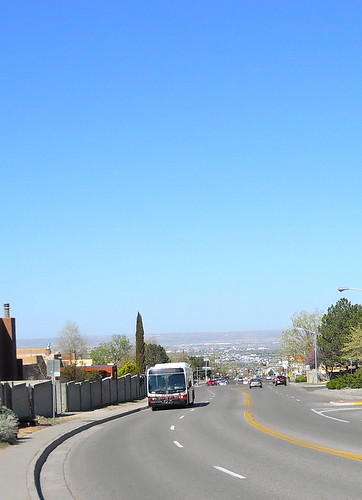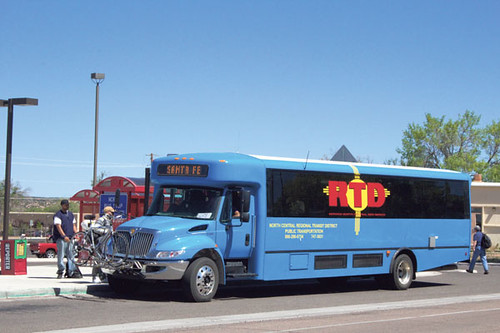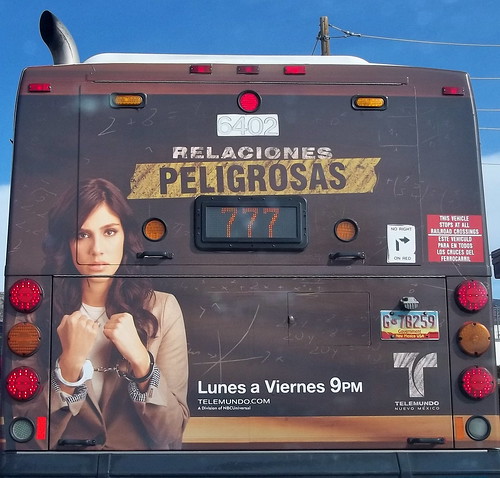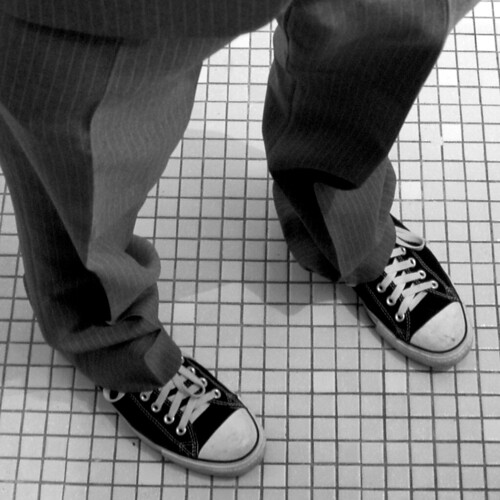BUS STORY # 311 (Uphill)
In Greek mythology, Sisyphus is condemned to push an enormous boulder up a mountain, only to watch it roll back down to the bottom, where he must begin the push all over again, for all eternity.
He sits down on the bench beside me, then leans over with his head in his hands.
He’s Native American, somewhere in his 30s. He’s in jeans and a plaid short-sleeved shirt, and is wearing a small backpack.
He straightens up in a few minutes and tells me he was up till four this morning doing homework.
He’s behind because he was gone a week.
He was gone a week because his aunt died and he had to go back home.
He’s probably gonna have to drop his keyboarding class, he tells me, and he really didn’t want to drop that class.
I ask him if he’s going to CNM. He’s going to SIPI -- Southwestern Indian Polytechnic Institute.
I know someone who teaches at SIPI and I ask him if he’s taking any science classes.
He’s taking some English and office management courses. He doesn’t need any science classes. He’s certified by the state in water, waste water, and biosolids. He’s changing his career.
I ask if his certifications aren’t getting him work. He explains there’s plenty of work, but not for him because he doesn’t have a driver’s license. A lot of water analysis work requires you to be mobile -- to go to where the water is. He covered the state from the Four Corners area to Las Cruces. He can’t do that since he lost his license.
It’s not what I’m thinking.
He says he went in to renew his license and they told him it was flagged. He asked why. Because he was behind in his child support payments. He had to make restitution or else he couldn’t renew his license.
He didn’t have $12,000, he explains.
It’s not like he wasn’t making payments, he adds. He says he always paid something every month -- but often could never make the full $450. He tried pleading his case.
It didn’t matter. No restitution, no driver’s license.
He had a job at the time, but once he couldn’t drive, he was of little use to his employer, and he was let go.
He scrambled. He found a job where he could stay put, but shortly afterwards, his employer moved to Mexico, then cut everybody’s wages. He found a job in Arizona, near Holbrook, on the edge of the Navajo Nation, which he said was especially interesting because it involved water and heavy metals.
Unfortunately, he did not apply for certification reciprocity in Arizona. Sometime after submitting a sample using his New Mexico certification number on it, he got a call from Santa Fe, and that was the end of that.
Then he found a local job as a contractor, but it only lasted six months.
Sometime during his scrambling, his ex-wife lost her job with PNM. He says they gave her a pretty good severance package -- fully-funded four years of education, plus a big lump sum.
He says he was happy for her. He’d already decided he needed to get a job that would keep him in one place and didn’t require a car, and going back to school like his wife seemed like the best way to do that. He’s unemployed now, and going to school full time -- at least until he drops his keyboarding class. His new goal is office administration.
So: if I have the story straight, and if the story is true,* the state took away his ability to drive, which cost him his job, which put an end to his income, which put an end to any partial payment of child support he had been making, and put an end to any future child support payments at all until he graduates and gets a job. And it probably put him on at least one income assistance program to boot.
Meanwhile, the mountain of child support debt grows that much higher.
Of course, there at least three other sides to this story.
One thing seems apparent: He isn’t giving up. He doesn’t look or sound angry, or bitter, or beaten. He’s determined. He says he wants to get back to paying down that debt.
I tell him I admire his attitude and his spirit.
I don’t tell him how tall that mountain looks from down here, and how big that boulder is he’s put his shoulder to.
__________
*The day after this encounter, I called the New Mexico Human Services Department. Flagging a driver’s license for non-renewal is indeed one of the tools the department can use on a delinquent parent. Other tools include garnishing paychecks and blocking passports.
I also learned that such sanctions are not necessarily automatically imposed. Often, the parent not getting the child support asks the department to take action, which they often do. Other times -- for example, when the state is having to help support a parent and children because the child support is not coming in -- the state will step in without a request.
BUS STORY # 310 (Airplane Bus Story)
I’m flying to Baltimore. My seat mate is wearing jeans, a short-sleeve striped shirt, straw cowboy hat, and a watch set in a silver cuff bracelet and flanked by turquoise stones.
We get to talking about New Mexico, and about our grandchildren. He asks me what I do, and I tell him. I return the question, and he says, “I’m in public transportation.”
What are the odds?
Turns out he works for the North Central Rural Transit District up north. Their job is to stitch together the schedules of any number of small, local transit systems, including those of several of the pueblos, to make getting around the northern part of the state possible.
They also operate part of the service themselves. Locals know them as “the blue bus.”
I ask him about funding in the current economic and political environment. He acknowledges they are heavily dependent on the Feds and local government for support. Equipment procurement comes largely from securing grants which are funded anywhere from roughly 50 to 80 percent by the U.S. Department of Transportation. The administrative overhead and day-to-day operations come out of local gross receipts taxes -- not necessarily a dependably fixed amount.
He understands we may be looking at an austerity budget in the near future, but he says most politicians understand the economic importance of rural public transportation, though it is difficult to measure.
A lot of that has to do with getting rural students to and from community colleges. Unemployment (with all its attendant welfare and other social services costs) is a chronic problem in this part of the state, and education has been heavily pushed as the realistic solution. (Not to mention that employment not requiring an education often involves illegal activities which, in turn, generate no tax revenue, but do cost taxpayers when law enforcement, the judicial system, and the penal system become engaged.)
We talk about ridership and gasoline prices. He says their tracking shows ridership goes up when prices go up, but when prices go back down, they retain much of the ridership. That is my sense of what happens here in Albuquerque.
We talk about alternative fuels. He believes the electric-diesel hybrids have been a real advance, and he cites continued improvement in both diesel engines and diesel itself in reducing particulate matter. He points out that hybrids only make sense for buses running longer distances between stops. That’s why we have them on our Rapid Rides, he adds.
We talk about electric, solar and hydrogen cell technology.
He is least optimistic about electric. He cites the size and weight of the batteries currently needed on our flex-bus hybrids, and says that, right now, a bus would either have to displace passenger capacity for battery capacity, or else develop routes that would accommodate frequent recharging stations. The batteries themselves are not all that long-lived, and are expensive to replace. And, he adds, it doesn’t really do all that much for the environment because the charging stations would be powered by fossil fuel-generated electricity.
I ask about solar-powered charging stations. He says solar panels -- unless there are a lot of them, and you are producing enough surplus energy to store in batteries -- are low voltage producers of electricity. Which translates into a long wait at the charging station between stops.
He thinks hydrogen has promise, but the cost-effective technology is a long way off. Right now, he says, the fuel cells used are so complex, a transportation system would have to have an engineer on site just to troubleshoot and oversee maintenance. Plus, once again, manufacturing hydrogen using fossil fuels would pretty much undercut the whole purpose of using hydrogen as a power source.
Later, I realize I failed to ask his take on compressed natural gas.
One of the most interesting discussions has to do with scheduling for paratransit systems like our own SunVan service. He explains that sophisticated scheduling software can process thousands of requests made in the previous 24 hours, converting them into a schedule of routes that will make the largest number of deliveries in the shortest amount of time using the least amount of fuel.
(We’ve recently purchased 40 new paratransit vans to replace some of the aging fleet. You can read more about that here.)
Back in Albuquerque, I will go looking for a photo of “the blue bus” for this post which will lead me to a number of articles about the NCRTD, the benefits it brings to the northern New Mexican communities, and stories from the local press, some suggesting a not-always stellar public service record at the administrative level. For those that are interested, I’ve posted the links below.
Website for the North Central Rural Transit District
“Bus-ted,” Santa Fe Reporter, 05/09/12
“The High Cost Of Free Rides,” Santa Fe Nw Mexican, 12/01/11
“Transit Boss Quits,” Albuquerque Journal, 04/26/11
“Espanola’s Blue Buses,” Horse Tail Trail, 08/10/10
__________
The photo at the top of this story is downloaded from the online 05/09/12 Santa Fe Reporter article, “Bus-ted”. The photo is not credited in the article.
BUS STORY # 309 (“It’s All On The Web”)
I’ve just boarded at UNMH and found a place on the bench seat across from the back doors.
I’m barely settled when the woman I’m sharing the bench with asks me if I’ve just come from the hospital.
No, I tell her. It’s just where I caught the bus this afternoon.
Oh, good, she tells me. You know the doctors and the lawyers there are in cahoots...
She is off and running, and I will spend the rest of the ride desperately trying to keep up.
I’m also trying to take her all in. It’s hard to tell her age. She’s wearing a shawl over a baseball cap. The shawl covers the sides of her face as well as her neck. Under the bill are intense dark eyes framed by black plastic. I look at her mouth and chin and guess “middle age.”
She also has a grocery cart which looks full, but is covered by a blanket.
She does not look like she’s on the street.
She looks me directly in the eyes, and she speaks coherently, articulately, rapidly, non-stop. I’ve now learned the UNMH docs and lawyers are in cahoots because they got rid of the incriminating x-rays that showed the fractures she suffered after her then-husband beat her up, which happened just six months after a court case involving the murder of her former boss and her husband’s co-worker was finally resolved after a six-year ordeal, the two linked not just by employment and marriage, but also by a shadow CEO of a front company who paid the attorney fees for both sets of lawyers...
She spins out a tale too rapidly told and too complex for me to keep up with. The story is larded with names -- first, last, and sometimes middle initials -- and with dates -- day, month, year. There are details like cops who show up from another jurisdiction and don’t Mirandize when they take someone away. Or the discovery of a notebook with diagrams of those x-rays that later were said to never have been taken. Or a manager trying to recruit an employee to dump someone else's newborn baby in a dumpster.
The constants are high-powered people involved in skulduggery and cover-ups, fixed court cases, suspicious goings-on behind the scenes of a nationally-known mega church, psychiatric institutions that combine insurance-looting with testing experimental drugs on hapless patients, a publishing company in Florida involved in shady business and getting away with it, and more...
It’s crazy talk, of course. We all know this kind of stuff doesn’t go on in real life, especially not here in the Good Ol’.
In fact, the story is so crazily tangled and obscure, and so tantalizingly conspiratorial, that I’m thinking it would make a pretty good Thomas Pynchon novel. Even the hero -- heroine, in this case -- is a Pynchon character: a schlemihl, whose seemingly innocuous choices of a spouse and a job send her tumbling down the Rabbit Hole, and how could she possibly have known where that was gonna lead...now finding herself on a bus in Albuquerque, New Mexico, and bearing witness.
I’m thinking if I’d had a tape recorder and she a longer ride, I’d have enough material for my own first novel. Assuming I didn’t run out of tape and had enough time to sort it all out.
But I don’t have a recorder, and she gets off about two-thirds of my way home. She gets up and grabs her basket, but she is still half-turned to me and still telling the story. She has another point to make, and the back doors close while she is talking. Without missing a beat, she calls out “Back door! I’m getting out,” and then continues until she is finished.
She steps off the bus, turns to look at me and, before the doors close a second time, tells me, “I’m not making this up. It’s all on the web.”
BUS STORY # 308 (Ted's Bus Story # 1)
Ever since my work schedule changed, I don’t see Ted* as often as I used to.
Ted is one of the regulars who is also blind. He works, and he uses the bus to get to work and back home.
I ran into him shortly after last year’s end-of-August schedule changes. He told me he’d taken a real hit. His first bus, the # 12 Constitution Commuter, had been moved up four minutes, and it had so disrupted his connections that he was having to ride the bus downtown to the transit center, then wait for his connection there. Those four minutes added almost an hour to his commute.
Ted’s story was just another one of many I’d heard. (You can read about some of them here.) I knew there were needs being met, but it seems that tweaking bus schedules is a lot like upgrading a computer program: the fix you get here breaks something else over there.
But this story has a happy ending.
I ran into Ted again near the end of May. First thing he told me was they’d put his old schedule back for the 12. He was delighted.
I asked him if that was one of the May 19 adjustments, and he said it was.
How did that happen, I asked him.
Well, he called ABQ RIDE and asked to speak to one of the planners. Ted told the planner what the August changes had done to his commute. When the new adjustments were announced, his old route had been returned to its original schedule.
I’m happy for Ted.
I’m also reminded that we are incredibly fortunate to be in a city with a public transportation system as responsive and committed to good service as ABQ RIDE. I have read far too many blogs and news stories from elsewhere not to realize Ted would have been out of luck in a lot of places.
It’s true we riders have a wish list a mile long. I figure that’s true of ABQ RIDE, too, and I’ll bet there’s a lot of overlap between their list and ours.
But I also know from Ted’s story, and from many others I’ve heard over the years, that we have a system that really does make an effort to meet its riders’ needs with the resources it has.
So, on behalf of Ted and the rest of us, thanks, ABQ RIDE. And please keep up the good work.
__________
*Real name changed.
BUS STORY # 307 (Portrait # 18: The Kid In The Gray Flannel Suit)
We board at the same place. Sometimes I get there before he does, sometimes he’s there before me. Either way, the bus comes quickly, and we board.
We take the same seats every morning. He sits in the seat across the aisle and one row up from mine.
From this angle, he kind of reminds me of a young Tom Cruise. And the way he’s dressed makes me wonder if he is, in fact, playing some kind of role.
He’s always in a suit. Sometimes it’s black, sometimes it’s pinstripes. Today, it’s dark gray. Always a white shirt with the cuffs visible at the end of his jacket sleeves. His ties are classy. His socks are sheer and black, and his shoes are cap toes, black and well-polished.
(Well, he’s not always in a suit. One morning he was wearing khakis, a blue blazer, and brown suede shoes. I figured it was Casual Day.)
Maybe it’s my age, or maybe it’s the culture, but I find myself wondering what this kid is doing in those grown-up’s clothes.
Still, there are kid signs. His hair sports that studied, mussed look that requires lots of product, and lots of mirror work.
He’s got on a pair of stylish, black designer sunglasses. They’re thick and clunky looking, but they’re stylish.
Later in the ride, he’ll raise the glasses to the top of his head. That’s stylish too, even though now there’s probably a lot of product on the inside lenses.
But not as stylish as it used to be. I’m seeing a lot of kids wearing their sunglasses backwards now, as if they had eyes in the back of their necks.
Maybe this makes glasses-on-top-of-head the conservative style these days.
He’s got the sunglasses on over his eyes when I first notice him. He’s reading with them on, which is probably why I noticed them in the first place.
He’s reading a slender magazine the size of a large appliance manual. The cover, however, is slick, with a black header and a blue body. I can make out the format on the pages from across the aisle: lots of very short, numbered paragraphs broken up by a series of bullet points -- never more than three. I can’t make out any of the words, and I have yet to get a clear view of the title on the cover. But he is studying it. I mean studying, too. He’s absorbed.
I’m thinking either the financial industry or the law.
And I’m thinking he might be an intern, not only because he looks so young, but also because he’s riding the bus.
So, which would be more likely to ride a city bus?
I’m leaning toward the law here. (I could be influenced by the fact one of my daughters-in-law took the bus to law school and her internship.) Lawyers -- solicitors, litigators, prosecutors, defenders, judges -- deal with the likes of us every day.
Financiers, on the other hand...
Yeah, I can’t picture it, either.
__________
The photo at the top of this story is titled “Chuck Taylors and a pinstripe suit,” © All Rights Reserved, and is posted with the kind permission of Punkartist. You can see all Punkartist’s photos on Flickr at: http://www.flickr.com/photos/punkartist/





